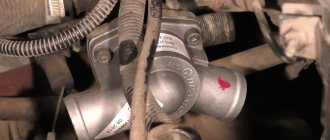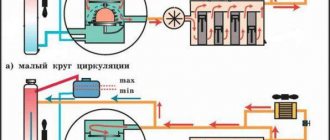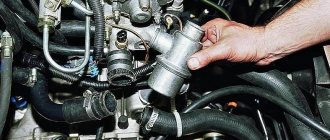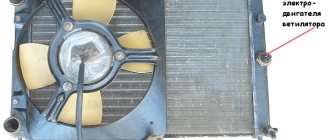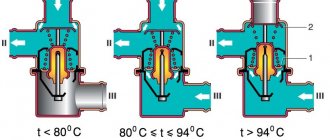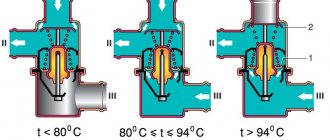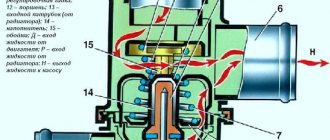When the car engine warms up too quickly, the electric fan turns on almost immediately, and the coolant temperature sensor needle inexorably approaches the red zone, threatening to overheat the engine, there is every reason to talk about abnormal operation of the cooling system. Very often the cause of this malfunction is the thermostat.
Drivers also make mistakes with the thermostat if the engine slowly warms up to operating temperature, and the temperature sensor needle is rooted to the spot at the beginning of the scale.
➡ Operating principle of the thermostat The purpose of the thermostat is to block access of coolant to the radiator until its temperature reaches a certain value (from 85 to 950 C). This task in most thermostats is accomplished using a valve leading to the lower radiator pipe.
Such a valve is connected by means of a pin to a cylinder filled with industrial wax, the melting point of which is 850 C. When the coolant is heated to the specified temperature, the wax also heats up to the same temperature. As it changes from solid to liquid, it expands significantly, pushing a pin out of the cylinder, which opens the valve.
As a result, the coolant begins to circulate through a large circle of the cooling system, releasing most of the heat through the radiator and cooling. As the engine temperature drops, the wax in the thermostat cylinder decreases in volume, closing the valve and circulating coolant through a small circle of the cooling system.
➡ Checking the operation of the thermostat on a car To check the thermostat, the car engine must be started and warmed up to normal temperature. 1-2 minutes after startup, when the coolant temperature gauge needle has just begun to deviate from the edge of the scale, you should check the heating of the pipes leading to the radiator. The lower pipe should remain cold, and the upper pipe should gradually warm up. The pipe leading to the interior stove should also be moderately warm.
As the engine warms up, the upper radiator hose should become hot and the lower hose should remain cold. When the thermostat response temperature is reached (applied to its body or indicated in the passport), the lower radiator hose will become warm, and then hot. This is evidence that the thermostat valve is operating. In warm or hot weather, the electric fan should also turn on. This is the normal operation of the thermostat.
If, during the process of warming up the engine, both radiator pipes become warm at the same time, this indicates that the thermostat valve, for a number of reasons, is constantly in the open position, starting the circulation of coolant throughout a large circle of the cooling system.
This option is also possible - the engine has warmed up, the electric fan has turned on, but the lower radiator hose remains cold. In this case, the thermostat valve remains constantly closed and does not open even when the coolant heats up, allowing it to circulate in a small circle of the cooling system.
Both of the latter options clearly indicate that the thermostat is faulty and must be replaced.
➡ Checking the functionality of a dismantled thermostat It is very easy to check the serviceability of a thermostat at home. All you need for this is a saucepan with boiling water. Having lowered the thermostat into boiling water, you should wait a few seconds until it heats up. If it is in good working order, it will be clearly visible how the rod has moved and the thermometer valve has opened.
In the same way, the closing of the valve will clearly occur if the thermostat is cooled under running water or in a saucepan with cold water.
If, as a result of home testing, it turns out that the valve does not open and/or close, therefore, the thermostat is faulty.
Engine overheating can occur not only due to a faulty thermostat. In some cases, insufficient circulation of coolant can be caused by failure of the water pump (pump) or “airing” of the cooling system due to improper replacement of coolant.
In this article we will look at how to check the functionality of the thermostat on VAZ 2110-12 cars without removing it.
First, let's look at the main thermostat malfunctions:
- The thermostat does not open: the most likely reason for this is that the valve plate is stuck.
- The thermostat does not close completely: a possible cause may be that a foreign object has entered the thermostat.
How to check the thermostat without removing it from the engine
So, the functionality of the thermostat can be checked as follows.
We start the engine and monitor the coolant temperature on the instrument panel. The opening temperature of the VAZ 2110-12 thermostat (main valve) is 85±2°C. When the engine temperature is below the specified value, the operating thermostat valve is closed and the coolant circulates in a small circle. This can be determined by feeling the lower radiator hose and the radiator itself. When the thermostat is closed, they should be cooler than the thermostat itself, since coolant does not enter the radiator.
When the temperature in the cooling system rises to 85 degrees, the main thermostat valve opens and the coolant begins to circulate in a large circle, accordingly the radiator begins to heat up, and then the lower radiator hose.
When the temperature reaches 102°C, the main radiator valve is fully open and the radiator in this case should be hot in the upper part and slightly colder in the lower part, and the lower hose should also be hot.
If, when the temperature is reached when the thermostat valve should open, both the lower pipe and the radiator are cold, then the thermostat valve does not work, and accordingly the thermostat is out of order and needs to be replaced.
A malfunction in which the thermostat does not close completely can be checked just as easily: if after starting the engine the radiator immediately becomes warm like the thermostat housing, but the interior hardly heats up, then the most likely reason for this is incomplete shutting of the thermostat. This can cause the engine to wear out quickly as it does not reach operating temperature. In this case, it will also need to be replaced.
Many motorists, when operating the 16-valve VAZ-2112 engine, encountered the fact that the engine simply boiled. This is due to the engine overheating. What is the operating (normal) engine temperature? In this article, we will consider what temperature should be in the power unit and its systems, as well as the reasons and methods for solving an increase in this indicator.
Tips before starting the procedure
- Before you begin removing the thermostat on a VAZ 2112, be sure to ensure that it has completely cooled down after operation.
- The thermostat is removed when it is replaced due to unstable engine temperature conditions (overheating, insufficient heating). To carry out this procedure, completely draining the coolant is not necessary.
- To check the condition of the thermostat, start the car engine and touch the lower radiator hose, at first it should remain cold, and only after the coolant temperature reaches about 90 degrees, the hose will begin to gradually heat up. If there is no such reaction to the manipulations performed, remove the thermostat from the car and check its functionality; if defects are detected, it must be replaced with a new one.
This is interesting: What is power steering fluid and is it possible to mix different brands
What should the engine operating temperature be?
Engine operating temperature shown on the instrument panel
If we take the information from the international convention of automobile manufacturers dated December 1, 1992, then the uniform standard for engine operating temperature is considered to be 90 degrees Celsius. With such indicators, the engine operates as efficiently as possible and does not create residual negative effects.
When switching to more advanced engine manufacturing technologies in 2004, it was accepted that a specific indicator of this indicator cannot be held in one position, and therefore they made a gradation of acceptable standards, which amounted to 85-105 degrees Celsius.
Engine overheating shown on the instrument panel
According to data from the manufacturer AvtoVAZ, on a 16-valve VAZ-2112 engine, the operating temperature of the engine is considered to be 87-103 degrees Celsius.
At this temperature, all systems function normally, and the motor is not subject to negative factors and consequences.
Cooling system design
The engine cooling system has many components that are interconnected, and if one fails, the entire system will not be able to function. So, let's look at the location diagram and decoding of the indicators for the cooling system of a 16-valve engine.
Diagram of the cooling system operation
1 – heater radiator; 2 – steam removal hose of the heater radiator; 3 – outlet hose; 4 – supply hose; 5 – coolant temperature sensor (in the block head); 6 – pump supply pipe hose; 7 – thermostat; 8 – filling hose; 9 – expansion tank plug; 10 – coolant level indicator sensor; 11 – expansion tank; 12 – exhaust pipe; 13 – liquid chamber of the carburetor starting device; 14 – radiator outlet hose; 15 – radiator supply hose; 16 – radiator steam outlet hose; 17 – left radiator tank; 18 – sensor for turning on the electric fan; 19 – fan electric motor; 20 – electric fan impeller; 21 – right radiator tank; 22 – drain plug; 23 – electric fan casing; 24 – timing belt; 25 – coolant pump impeller; 26 – supply pipe of the coolant pump; 27 – coolant supply hose to the throttle pipe; 28 – coolant drain hose from the throttle pipe; 29 – coolant temperature sensor in the outlet pipe; 30 – radiator tubes; 31 – radiator core.
Main malfunctions and ways to solve them
In fact, there are quite a lot of components in the cooling system that are susceptible to failure. This depends not only on the service life, but also on maintenance, as well as the quality of the parts. So, let's look at the main components, faults and methods for solving them.
Cooling radiator
Cooling radiator pulled from the engine
As practice shows, this part lasts quite a long time. The main cause of failure is clogged internal channels. So, if the blockage is sufficiently dense, the engine begins to heat up, the high pressure created by the pump can lead to a rupture of the tube and the radiator will leak.
Some car enthusiasts have it soldered and cleaned, but as practice shows, after a short period of time, a leak forms again. Therefore, if this part fails, it must be replaced with a new one.
Heater radiator
Heater radiator assembly with fan
Pipes
KIT kit of cooling system pipes
One of the main components of the cooling system, since it is through the pipes that the fluid circulates through the system.
The main malfunction is considered to be wear, namely the appearance of cracks and leaks of coolant. To fix the problem, you need to replace the damaged element.
Of course, it is recommended to change everything in sets, since it is unknown how many kilometers later another one will have to be replaced, and the process itself requires draining the coolant.
Water pump
Water pump removed from the car
The pump circulates coolant throughout the system. So, if a leak occurs from the water pump bearing or noise increases, these are the first signs that the part needs to be replaced.
Thermostat
Thermostat disassembly process
The thermostat is the part of the cooling system that is most often replaced.
Thus, the first signs of a unit malfunction are considered to be an increase in the operating temperature of the engine to the maximum, as well as frequent turning on of the cooling fan. To fix the problem, you need to replace it with a new product.
Radiator cooling fan
Electric fan with casing removed
This part provides cooling of the liquid, but if there is insufficient oncoming wind flow, it is this part that additionally creates an air flow. The cooling fan prevents the temperature from rising to a critical level.
It turns on at 100 degrees Celsius, and turns off at 94.
Cooling system sensor
Cooling sensor location
Part of the engine management system that sends a pulse to the ECU to turn the cooling fan on or off and also reports the status and changes in engine operating temperature. If it fails, the part must be replaced to eliminate the malfunction.
conclusions
The operating temperature of the 16-valve VAZ-2112 engine is 87-103 degrees Celsius.
If this indicator increases, the engine may boil, which in turn can lead to serious negative consequences, such as bending of the cylinder head or major engine overhaul. It is worth carefully monitoring the condition of the components and parts of the cooling system, because they ensure normal cooling and operation of the power unit.
The thermostat is an important component in the engine cooling system of any car. The stability of cooling and the performance of the engine itself depend on its operation. The article describes the purpose of this part, how to check its performance, replacing the thermostat on a VAZ-2112 with a 16-valve engine, the best original components and their factory part numbers.
What is a thermostat?
This is not a standard 6 "hole" thermostat
The thermostat itself is an important part in the engine cooling system. It is designed to ensure that the engine is cooled according to its needs.
For example, you started the engine “cold”, then at degrees from 80 to 90 a large circle opens and liquid enters the radiator and begins to cool the engine more intensively than in a small circle.
Thermostat operating principle
The thermostat itself consists of:
- Frame.
- Internal compartment.
- 2 pipes with valves.
- "Core". Thermoelement (copper powders, a mixture of granulated wax, graphite and aluminum in a special proportion).
- Valves.
How to identify a breakdown?
But there are also auxiliary signs: there is no heat in the cabin when it gets cold, a decrease in dynamic performance (power, speed), increased fuel consumption (about the passport consumption standards here).
Types of thermostat breakdowns
Device
How to determine where the thermostat is located on a VAZ-2112 with a 124 engine with 16 valves? Quite simple. It is located in the engine compartment under the air purification filter housing. The part is covered with a special protective casing. This mechanism is a brass cylinder with 6 outlet tubes. At the top of the body there is a mechanical valve with a special powder composition.
Where is the thermostat located
In order to check the operation of the thermostat on a car, you first need to find it. That is, you need to know exactly where this part is located. This is quite easy to do.
First of all, in the engine compartment you should find the thickest pipe - the upper radiator hose, which goes from the radiator (it is always in front of the engine) to the engine. This pipe will inevitably be attached at its second end to the thermostat, or rather, to its body. This scheme is used on most domestic cars and on many foreign-made cars.
Purpose
The main purpose of the thermostat is to regulate the gradual heating of the engine. After starting the engine, the antifreeze is not warm enough. The thermostat prevents the passage of antifreeze through the engine. As soon as the coolant has heated to a temperature above 80 degrees, the valve opens, allowing antifreeze into the engine, opening a full circulation circle. The VAZ-2112 with a 124 engine has a similar thermostat with 8 valve models. The only difference is the resistance of the throttle opening (bypass valve). On 16 valve models the resistance is higher.
Possible faults
The thermostat is a fairly simple and reliable part, but it has its own service life. The main malfunctions of the thermostat on the VAZ-2112 include:
- Valve jamming in seat. Occurs due to exposure to scale or contamination. This problem often occurs in cars whose engines have not been started for a long time.
- Incomplete valve closure. Occurs due to loss of elasticity of the return spring or dirt getting under the valve seat.
A faulty unit causes the following malfunctions:
- The engine overheats at idle speed. The reason for the valve being stuck in the seat. Even when driving at high speed, the fluid does not cool.
- The engine takes a very long time to heat up. The reason is the lack of contact between the valve and the seat. Some of the antifreeze gets into the engine.
Any of these faults requires a timely check of the part for serviceability.
Functionality check
It is extremely important to check the thermostat for functionality. This will help to accurately identify the faulty element of the circulation system. There are 2 diagnostic options: in a heated liquid or directly on a running unit.
On-site diagnostics
This check does not require removing the thermostat. The test can be carried out in the field, without the use of tools. Necessary:
- Start the cold engine.
- Allow the antifreeze to warm up to 80 degrees.
- Touch the lower pipe connected to the unit being tested.
At the beginning this pipe remains cold. After the temperature rises above 80 degrees, the thermostat valve should open and the antifreeze itself should heat this pipe. The thermostat is faulty if:
- The pipe did not heat up. In this case, the thermostat did not come out of the seat.
- The pipe began to heat up simultaneously with the radiator. The valve does not block access to the full circulation circle.
If one of the described malfunctions is detected, the thermostat will need to be replaced.
Diagnostics with dismantling
A very simple way. To check, you need to remove the part from its seat. Further:
- Fill the container with water.
- Heat the container.
- Immerse the part being tested completely in the liquid.
- Monitor the temperature of the liquid using a technical thermometer.
After heating the water to t = 85–95 degrees, the rod should begin to extend and the thermostat valve should open. If this does not happen, the part is considered faulty.
After the valve has opened, the thermostat must be removed from the heated water. Cooling of the removed part will cause the valve to close. If the valve remains open, this means that the return spring has lost its elasticity and such a thermostat is considered unusable.
The already removed part can be cleaned of scale and dirt. Then repeat the check. If the result remains the same, the part must be replaced.
Replacing a faulty thermostat
A faulty thermostat requires urgent replacement. For this procedure you will need:
- Container for draining liquid.
- Phillips screwdriver.
- Hexagon "5".
- Coolant in a volume of 1–2 liters.
- New thermostat.
Replacing the thermostat on a VAZ-2112 is carried out only on a completely cooled engine. Next you need:
- Drain the antifreeze.
- Remove the air purification filter cover.
- Loosen the clamps of the two upper thermostat pipes.
- Remove the pipes.
- Remove the 3 thermostat valve cover bolts using a hex socket.
- Remove the cover.
- Remove the valve and rubber ring.
- Clean the seat from dirt.
- Replace the faulty unit.
The replacement process is carried out exactly the other way around. There is no need to completely change the thermostat. This is necessary in case of damage to the housing or tubes.
The process of replacing a thermostat on a 16 valve valve
First, you need the thermostat itself for your car model, a screwdriver and a “5” hexagon.
Of course, the first thing you need to do is remove the no longer working thermostat:
- We drain the coolant, since otherwise it will not be possible to disconnect the thermostat (there will be liquid in the system).
If you don't drain the coolant, you can "crash the engine compartment"
Removing the air filter cover
Loosen these clamps on the thermostat.
Unscrew the bolts on the thermostat
Articles
The use of original spare parts will extend the working time of components and assemblies. This applies to replacing the thermostat. The best options for the VAZ-2112 are produced by the following companies:
- "Bautler" with article number 210821306010,
- "Luzar" with article number LT010892,
- "Pekar" with article number 21082-1306030,
- with article number 21082-1306010-25.
- The thermostat from the VAZ-2110 shows good circulation indicators.
In order to understand which thermostat is better to install on a VAZ-2112 with a 16-valve engine, you must first focus on your available budget.
To select a quality thermostat, you must adhere to the following recommendations. When purchasing, you should pay attention to the material from which the spare part is made. Metal, aluminum, plastic cases will indicate a fake. Original thermostats are made only from copper or brass. It is also worth checking the valve spring travel. The spring should not be weak, move from its seating position, or be very rigid. The pipes for attaching the nozzles should not have any unevenness, cracks, or chips. In large dealership centers, the part can be checked at a special stand.
How to replace a VAZ-2112 thermostat with 16 valves yourself
The main purpose of the thermostat is to control the heating of the 16-valve engine, which is installed in the VAZ-2112 car. The design of the thermostat includes a valve containing a special substance. As soon as the VAZ-2112 begins to heat up, the valve opens and liquid enters a large circle to cool the 16-valve engine.
If the coolant does not flow into a large circle, the car will overheat, which can lead to serious consequences. To avoid this, you should constantly monitor the technical condition of the machine; replacing a broken thermostat should be done in a timely manner.
A little about the thermostat?
The thermostat is a mandatory engine device in its self-cooling system. Its main purpose will be to cool the system while it is running.
For example, when starting a car “cold”, that is, when heated from 70 to 95 degrees, a huge circle starts up, and the liquid goes into the radiator and the process of self-cooling of the system begins to occur more strongly, compared to a small circle.
The VAZ-2112 thermostat for 16 valves consists of the following components:
How to check the health of the thermostat
To check the serviceability of the VAZ-2112 16-valve thermostat, do the following:
- start the car and warm it up to the desired temperature;
- open the car hood and inspect the appearance of the pipe;
- If the thermostat is working properly, the pipe will be warm to the touch.
Otherwise, that is, if the temperature of the pipe is not warm, the thermostat will need to be replaced immediately.
Under normal home conditions, you can check the part for serviceability in another way. To do this, prepare a container with liquid in which to place the thermostat. The vessel is heated on a gas burner, they look at the temperature indicators and control at what moment the part begins to open.
It should be noted that in the operating position, a serviceable element that controls engine heating should open at a temperature of 88 degrees. As soon as the temperature in the engine rises to this level, the lid opens and the coolant begins to move in a large circle. Thanks to this, the VAZ-2112 car does not overheat, it will continue to function normally at any speed.
Replacing it with a new part will help restore proper operation of the engine and prevent it from overheating.
Reasons why a thermostat may fail
The thermostat is responsible for maintaining the optimal temperature of the car engine.
An experienced driver can determine a malfunction of the VAZ-2110 thermostat for indirect reasons. They can be divided into the following points:
- Thermostat takes too long to heat up . This can happen due to unstable operation of the engine, which produces strong vibration. This can damage the valve of the device, causing antifreeze to get inside the thermostat. As a result, the device will work more slowly.
- The valve may also open earlier than expected . As a rule, this is the result of antifreeze getting into the element responsible for coolant temperature.
- The thermostat may open with a delay . Most often, this occurs due to leakage of the filler, which is responsible for the valve opening temperature.
- The thermostat works correctly, but the engine constantly overheats . This may occur due to the coolant moving only in a small circle. The engine may also overheat due to cracks in the pipes or radiator.
- Mechanical damage to the thermostat valve can also prevent it from working correctly.
- Manufacturing defects . Unfortunately, domestically produced spare parts are often produced with factory defects, which can lead to a whole series of unnecessary work, since after changing the thermostat, the car owner will look for the cause of the breakdown anywhere, but not in it.
- Destruction of the rubber seal . If oil gets into the coolant, it can quickly render all rubber parts and pipes that were in contact with the oil unusable.
Oil causes seals to break down.
How to solve problems on the VAZ-2110?
Most thermostat problems can be resolved on your own. As a rule, VAZ-2110 owners do exactly this.
It happens that, despite the normal operation of the thermostat, the temperature of the coolant in the engine is constantly above normal. If you are sure that the thermostat is working properly and the cooling radiator is new, clean and undamaged, then you should replace the device with another one.
The new thermostat should open at a higher coolant temperature.
If the device opens late, then you need to check the entire system for the presence of coolant in it. It happens that the tank is full, and air pockets in the system interfere with the full circulation of antifreeze.
Video on how to repair a VAZ-2110 thermostat
Thermostat valve malfunction
The thermostat may open early due to high pressure in the cooling system. Excessive pressure is very dangerous, it can lead to rupture of pipes or the radiator at best, and seizure of the engine at worst .
The thermostat valve may open early in the following cases:
- Increased engine speed.
- Failure of the thermostat spring.
The spring may cause the valve to operate early.
This last point is extremely broad. The reason may be either an insufficient amount of antifreeze in the system or a failure of the radiator, pipes, and so on.
How to replace a thermostat yourself
Replacing a faulty thermostat in a VAZ-2112 with 16 valves is a fairly simple matter, so even minor skills in car repair will help the car enthusiast to perform this operation on his own. The part is replaced in stages:
- Start work only with a cold engine to avoid getting burns on your hands.
- All liquid intended for cooling must be completely drained, since replacing the part involves disconnecting the pipe in which it accumulates. To avoid spilling liquid during this process, you should place a container of the appropriate size under the bottom of the car.
- For ease of operation, it is recommended to remove the hardened air filter housing.
- Using a screwdriver or wrench, unscrew the connectors that secure the hose to the thermostat. There should be two such hoses - one is for the radiator, the other is for the thermostat.
- Using a hex wrench, unscrew the bolts, in triplicate, that prevent the element cover from moving when the car is running. After removing the fasteners, you should simply carefully remove the part from its permanent place.
If, upon inspection of the cover, any defects are revealed in the sealing ring, for example, cracks or deformation, this will indicate that the ring has also become unusable and needs to be replaced.
All car parts should be assembled in the reverse order that was used during disassembly.
The information described indicates that replacing a faulty VAZ-2112 16-valve thermostat is an easy operation, and if you approach the event responsibly and carry out the process step by step, then everyone will be able to correctly replace the faulty part on their car.
Replacing the thermostat on VAZ 2110, VAZ 2111, VAZ 2112
Note! In order to replace the thermostat with a new one, you will need to stock up on: A screwdriver and one hexagon of approximately “5”!
Where is the thermostat located? It is located just below the air filter housing, you can see it very easily; to do this, open the hood of your car, then look for this same air filter housing in the engine compartment and after finding it, look a little lower, so to speak, under it, and that same thermostat will be installed there (Or rather its cover, and this unit itself is located inside the cover), for example, the location of the cover is also shown in the photo below:
When should you change the thermostat? It is replaced only if it has stopped opening the valve that releases coolant to a large circle, and also if it has left the valve in the open position and this valve is jammed.
Note! In the first case, if the thermostat does not release liquid in a large circle, then the car will begin to heat up very much, in no case allow it to overheat and, if possible, replace the thermostat as soon as possible, especially if the engine of your car operates at elevated temperatures, then your cylinder head gasket will gradually burn out, and the friction in your car’s engine will also increase, because as we all know from the law of physics, the higher the temperature, then the metal expands accordingly, and the larger the metal becomes, the larger it becomes its friction, so watch the engine overheating very carefully.
In the second case, if your valve gets stuck in the open position, although this happens rarely, you still decide for yourself whether you need to replace the thermostat or not, because if the valve is in the open position, then the engine will practically not heat up , but if it’s winter outside, it would still be better to replace this unit with a new one!
How to check whether the thermostat is working or not? There are several ways to check, namely with this unit removed, and you can also check it directly without removing it from the car at all, to do this, just start the car and warm it up to operating temperature and after warming up, get out of the car (By the way, open the hood again before leaving) and look into the engine compartment, there you will find the lower pipe that comes from the thermostat, so feel this pipe thoroughly, it should be slightly warm at the very beginning, and then gradually warm up (Depending on the temperature of the engine).
Note! If it turns out that the lower pipe does not heat up at all but constantly remains cold, then this indicates that the thermostat has become unusable and it is time to replace it with a new one, by the way, due to this course of circumstances, the engine will heat up very strongly and quickly, so if all the symptoms are obvious, then the thermostat has really become unusable, and by the way, about such a check, see in more detail in the video clip below:
If you bought a new thermostat or found an old one in your garage and want to find out if it works or not, then watch the interesting video below that explains in detail how to check this unit separately from the engine:
How to replace the thermostat on a VAZ 2110-VAZ 2112?
Note! We will give you one piece of advice, it is recommended to replace this part only when the engine is cold, because if you decide to replace it on a hot engine, you will most likely get burned because when the engine heats up too much, the liquid also heats up, and if it gets on your skin, then this It may even cause burns, so be careful!
Removal: 1) At the very beginning of the operation, drain all the coolant from your car’s engine, otherwise you won’t be able to replace the thermostat normally, since you will have to disconnect the pipes from it that contain the liquid. (For information on how to drain the liquid, see the article entitled: “Replacing coolant in a VAZ”)
2) Then remove the air filter housing itself so that it does not interfere with further work. (For information on how to remove the housing, see the article: “Replacing the air filter housing”)
3) Then, when the liquid is drained and the body is removed from the car, pick up a screwdriver or a wrench (Depending on what type of hose clamps are attached that are connected to the thermostat) and use them to loosen the clamps of all hoses (Hoses should there are only two, namely the radiator hose and the coolant pump hose) which are connected to the thermostat and then disconnect them, by the way, you can also see both of these hoses in the photo below, they are shown with arrows.
4) Next, take the hexagon in your hands and use it to unscrew the three bolts that secure the thermostat cover itself, and after unscrewing, carefully remove it.
Note! The thermostat itself will be installed inside this cover; in the photo below it is indicated by a red arrow, so you remove it from the cover and thereby replace it with a new one!
By the way, there will also be a sealing ring installed on the thermostat cover (Indicated by a blue arrow), if it is heavily compressed or cracked, or simply damaged or broken, for example, then in this case replace this ring with a new one!
Installation: Installation of the new thermostat and all previously removed parts is carried out in the reverse order.
Additional video: If you need some advice on how to remove the thermostat and a little about the expansion tank, then watch the video below, which explains all the nuances that you will encounter when replacing this unit:
The other day I checked whether the thermostat was working or not, using this method which is described here, in the end I came to the conclusion that it works because all the hoses become hot when the engine warms up and when I press them again, I feel that there is liquid inside, but from Why is my car overheating, if not because of the thermostat, please tell me?
Hello Vladislav! And you add coolant at normal intervals, it doesn’t go away very quickly, because it’s possible that a hole has formed somewhere in the hose and through it air slowly enters the system and at the same time the liquid also pours out, and that’s why it’s possible your car is running so quickly and overheats. Also check the coolant level, if necessary, bring it to your normal level. It is also possible that you have an air lock in the system, which appears after the system is depressurized, that is, after replacing any part that is part of the cooling system and after replacing the coolant itself! (For information on how to remove an air lock, see the article entitled: “Removing an air lock in the cooling system”)
Note! Also, the engine may still be overheating because you have low-quality or too old coolant that needs to be changed from time to time! (For information on how to replace the fluid, see the article: “Replacing the coolant”!
Leave a comment Cancel reply
How to remove the old thermostat VAZ-2110
You do not need to have any special knowledge for this procedure; just follow simple instructions. First, the task of the car repairer is to drain the old coolant. How to do this correctly?
- disconnect the engine splash guard installed on the VAZ-2110;
- unscrew and remove the plug from the tank;
- To prevent coolant from spilling past, place a 6-8 liter container under the radiator, this is the maximum volume of coolant;
- the container should be placed directly under the hole located on the cylinder block;
- Using a size 13 wrench, unscrew the plug located on the drain hole on the block, and then drain the remaining fluid.
Removing the thermostat, in turn, looks like this:
- Locate the bleeder hose coming from the radiator.
- There are clamps on this hose that need to be loosened.
- Now locate the inlet hose of the pump pipe and the hose that serves as the connection between the thermostat and the outlet pipe. Loosen the clamps again.
- Remove the old model.
Installation of a new sample is carried out in the reverse order. It is best to mount a six-hole device, and if you have the ability to create and modernize different designs, you can try to modify the product. Don't forget to fill the cooling system with new solution.
The process of removing and replacing the old device with a new one is clearly shown in the video below:
Replacing the thermostat VAZ 2112
Replacing the VAZ 2112 thermostat is necessary if it has stopped opening the valve that releases antifreeze in a large circle to cool the engine, as well as if the valve remains in the open position or is jammed. Replacing the thermostat of a VAZ 2112 16-valve engine is no different from replacing it with an 8-valve one. The only difference is that the thermostat of the 16 valve VAZ-2112 engine has an increased resistance of the bypass valve (throttle hole), due to which the fluid flow through the heater radiator increases.
What is a thermostat for and how does it work?
So, as has already become clear, the thermostat is part of the engine cooling system. Its purpose is to open or block the movement of liquid along a small or large cooling circle. The principle of operation is based on the fact that when heated, physical bodies expand.
The thermostat device is relatively simple: a cylinder filled with a special mixture of wax, powdered copper, graphite and aluminum. There is also a rod placed inside this cylinder, two spring-loaded valves (main and small circle) attached to the said rod. While the engine is running, the cylinder is flushed with coolant. Thanks to this, heat is transferred to the wax. When heated, the latter expands greatly, squeezing out the rod with the small circle valve. As a result, the small circle closes and the liquid begins to circulate through the radiator.
Signs of a malfunction of the VAZ 2112 thermostat
If the thermostat does not release liquid to a large circle, the car will begin to heat up very much - do not allow it to overheat under any circumstances and replace the thermostat as soon as possible, because if your car’s engine operates at elevated temperatures, the gasket will gradually burn out cylinder head.
There are 5 main signs of a thermostat malfunction:
- The car engine takes a long time to reach operating temperature.
- The engine overheats quickly.
- The engine temperature gauge drops at lower speeds than usual and rises after stopping.
- After several minutes of operation, when the lower pipe is warm, this already indicates a prematurely opened thermostat.
- If the lower hose is cold while the engine temperature is close to boiling, this indicates a stuck thermostat.
Common thermostat malfunctions
Most often, service station workers diagnose the following faults in domestic VAZ-2110 cars:
- The valve is stuck in the closed position, there is no response to an increase in temperature. The coolant moves taking into account only a small circle.
- When the valve is stuck open, coolant leaks through the radiator, causing the engine to fail to reach the required temperature.
- The valve does not open or does not close completely.
Methods for checking the VAZ 2112 thermostat
There are several ways to check, namely: without removing the thermostat and with dismantling.
To check the thermostat without removing it. You need to warm up the engine to operating temperature. Then find the lower pipe that comes from the thermostat and feel it - at the very beginning it should be slightly warm, and then gradually warm up. If the lower pipe does not heat up at all, but constantly remains cold, and the engine heats up very quickly and strongly, this indicates that the thermostat has become unusable and it is time to replace it with a new one.
Checking the removed thermostat (both old and new) is done as follows:
- lower the thermostat into water heated to a temperature of about 80 degrees;
- raise the water temperature another 10 degrees;
- observe the “behavior” of the new device: if you notice that the rod begins to extend from the silicone element, this means that the thermostat is operational.
What are the signs of a broken thermostat?
As mentioned above, the thermostat opens one heat exchange circle and closes the second. If this element fails, then two options are possible:
- The thermostat constantly blocks a large circle of coolant circulation. This leads to overheating of the engine, which will be noticeable on the dashboard. Overheating, in turn, entails a lot of negative consequences: deformation and destruction of individual components, jamming;
- Thermostat is stuck open. That is, the coolant circulates through the radiator all the time. During the warm season, no problems may arise. But in the cold and, especially, in the frost, the engine will not warm up to operating temperature (about 90 degrees Celsius). This leads to significant excess fuel consumption, the interior heater (stove) does not work, etc.;
If there are signs of problems, you can check the thermostat without removing it or taking the car to a car service center.
